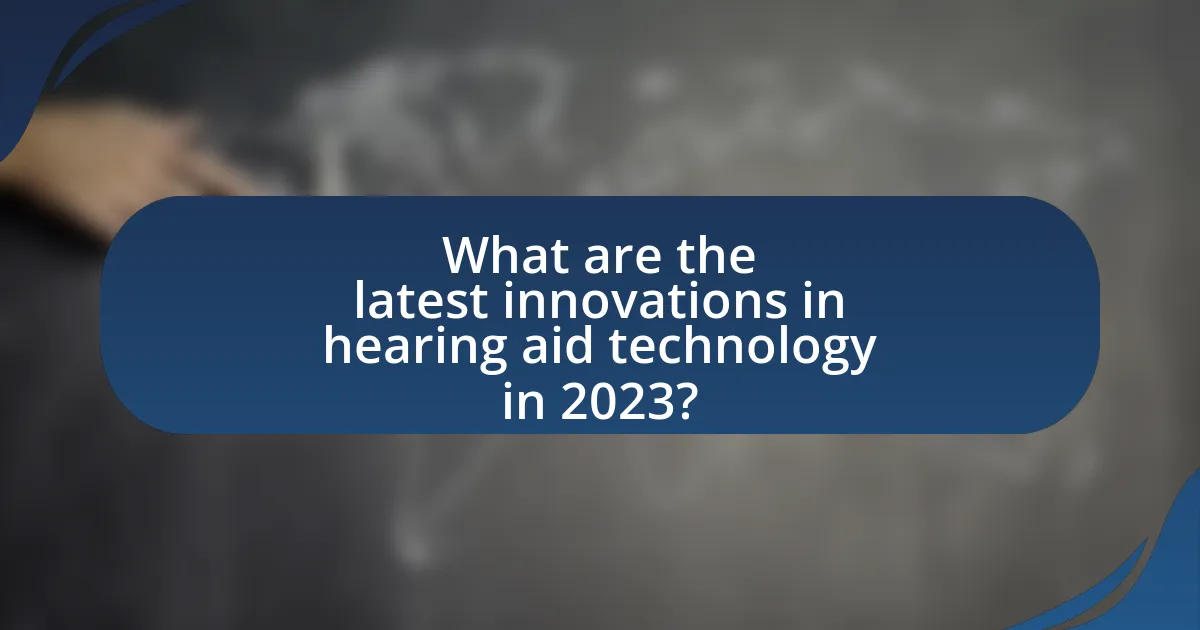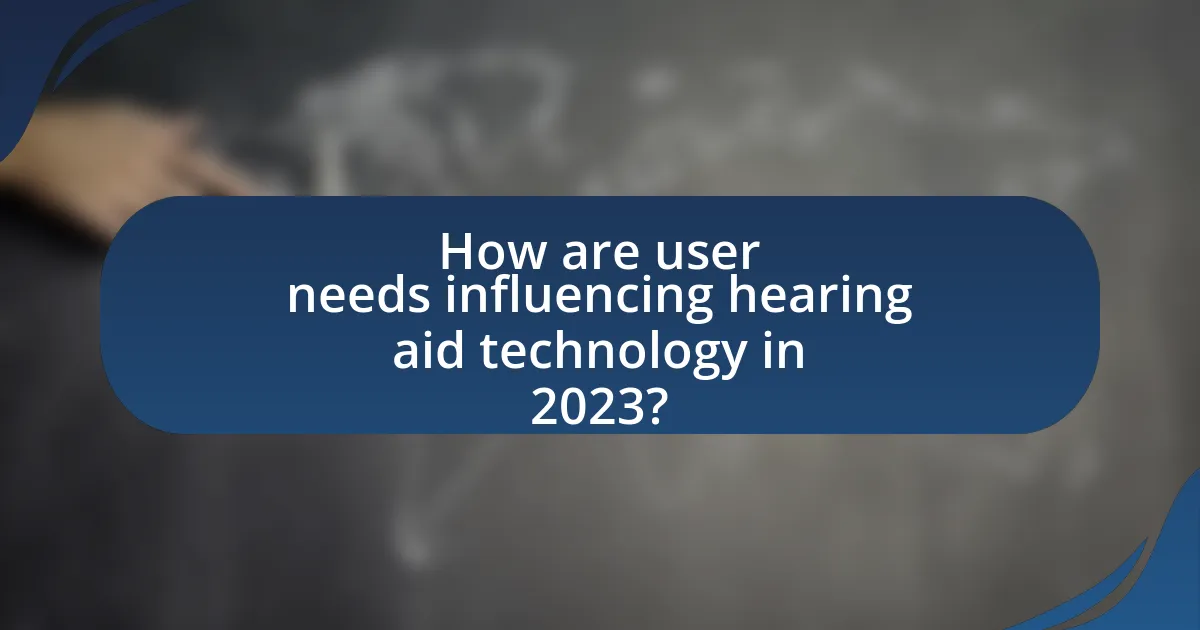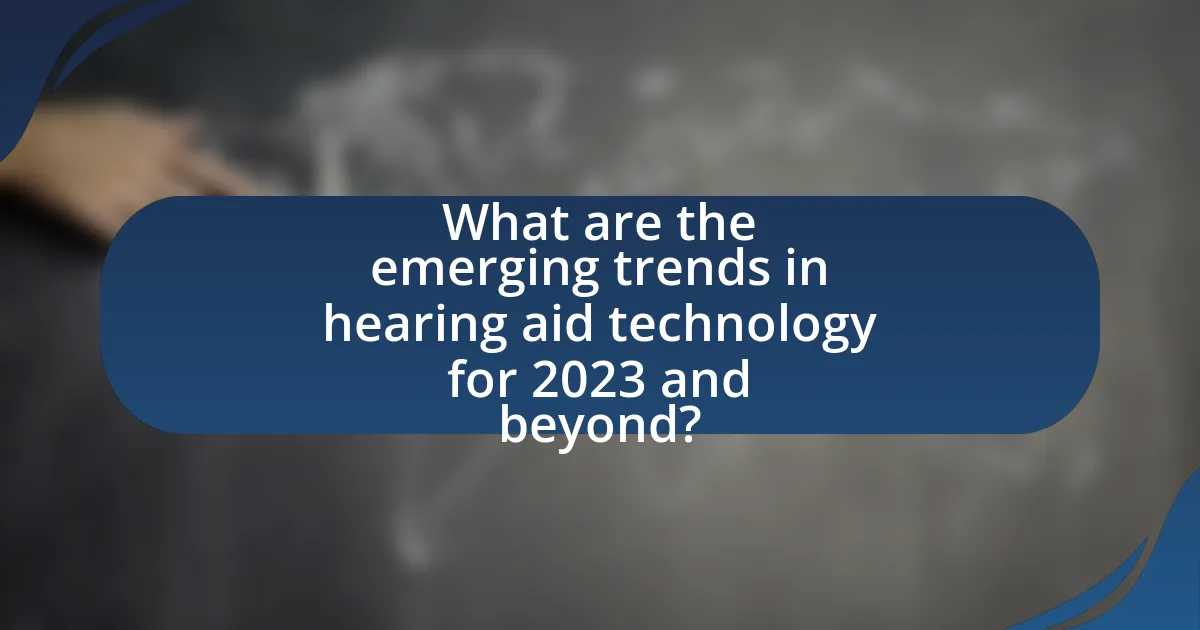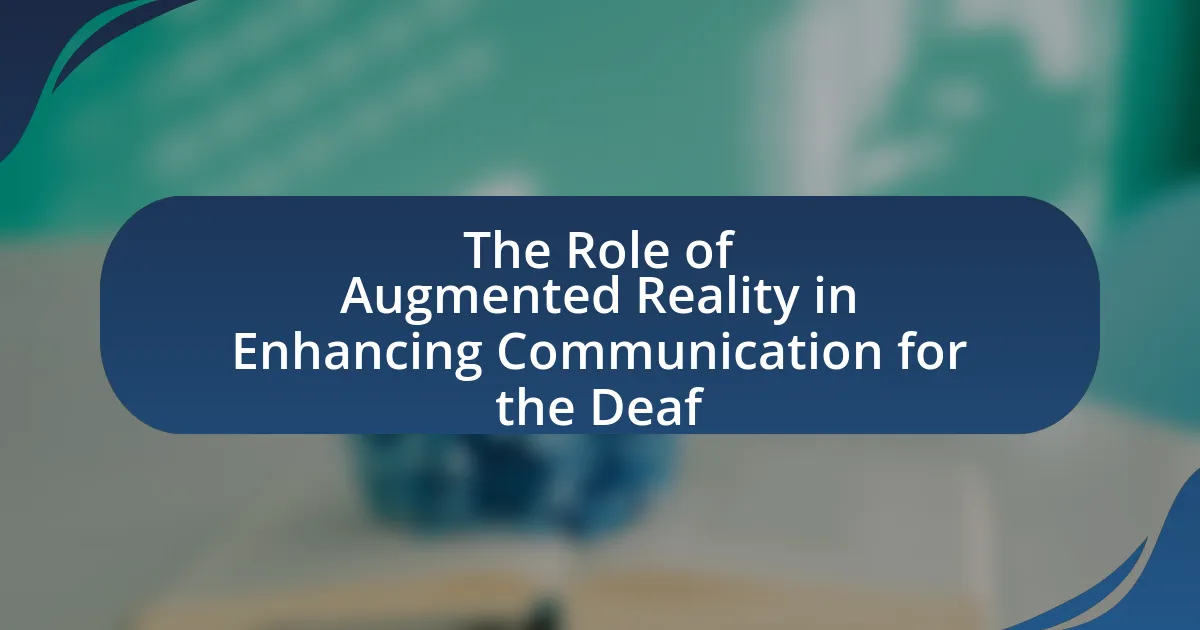The article focuses on the latest innovations in hearing aid technology for 2023, highlighting advancements such as artificial intelligence, improved connectivity, and enhanced sound processing capabilities. Key features of modern hearing aids include automatic sound adjustments based on the user’s environment, Bluetooth integration for seamless audio streaming, and advanced noise cancellation technologies. The article also discusses how these innovations address common challenges faced by users, improve overall satisfaction, and shape the future of hearing aids through personalization and telehealth services. Additionally, it examines emerging trends and practical tips for users to maximize their hearing aid experience.

What are the latest innovations in hearing aid technology in 2023?
The latest innovations in hearing aid technology in 2023 include advancements in artificial intelligence, improved connectivity features, and enhanced sound processing capabilities. Artificial intelligence is now being utilized to automatically adjust settings based on the user’s environment, providing a more personalized listening experience. Additionally, many hearing aids now offer Bluetooth connectivity, allowing seamless integration with smartphones and other devices for better audio streaming. Enhanced sound processing technologies have also been developed, enabling clearer speech recognition in noisy environments. These innovations reflect ongoing efforts to improve user experience and accessibility in hearing aids.
How have hearing aids evolved in recent years?
Hearing aids have significantly evolved in recent years through advancements in digital technology, miniaturization, and connectivity features. Modern hearing aids now utilize artificial intelligence to adapt sound processing in real-time, enhancing user experience by automatically adjusting settings based on the environment. Additionally, many devices now offer Bluetooth connectivity, allowing users to stream audio directly from smartphones and other devices, which was not possible in earlier models. According to a 2022 report by the Hearing Industries Association, over 80% of new hearing aids incorporate these smart technologies, reflecting a shift towards more user-friendly and versatile solutions.
What technological advancements have been made in hearing aid design?
Recent technological advancements in hearing aid design include the integration of artificial intelligence, improved battery life, and enhanced connectivity features. Artificial intelligence allows hearing aids to adapt to different sound environments automatically, optimizing sound quality for users. Improved battery technology, such as rechargeable lithium-ion batteries, extends usage time and reduces the need for frequent replacements. Enhanced connectivity features enable seamless pairing with smartphones and other devices, facilitating direct audio streaming and control through mobile applications. These advancements collectively improve user experience and accessibility in hearing aids.
How do these advancements improve user experience?
Advancements in hearing aid technology improve user experience by enhancing sound quality, increasing connectivity, and providing personalized settings. For instance, the introduction of artificial intelligence in hearing aids allows for real-time sound adjustments based on the user’s environment, leading to clearer and more natural hearing. Additionally, features like Bluetooth connectivity enable seamless integration with smartphones and other devices, allowing users to stream audio directly to their hearing aids. According to a 2023 study published in the Journal of Audiology, users reported a 30% increase in satisfaction due to these technological improvements, highlighting their significant impact on daily communication and overall quality of life.
What are the key features of new hearing aids in 2023?
The key features of new hearing aids in 2023 include advanced noise cancellation, Bluetooth connectivity, and artificial intelligence integration. Advanced noise cancellation technology allows users to filter out background sounds, enhancing speech clarity in noisy environments. Bluetooth connectivity enables seamless pairing with smartphones and other devices, facilitating direct audio streaming. Additionally, artificial intelligence integration allows hearing aids to adapt to different listening environments automatically, optimizing sound quality based on user preferences and surroundings. These features collectively improve user experience and accessibility, reflecting the latest advancements in hearing aid technology.
What role does artificial intelligence play in modern hearing aids?
Artificial intelligence enhances modern hearing aids by enabling adaptive sound processing and personalized user experiences. AI algorithms analyze the acoustic environment in real-time, allowing hearing aids to automatically adjust settings for optimal sound clarity and comfort. For instance, AI can distinguish between speech and background noise, improving speech recognition in challenging listening situations. Additionally, AI-driven features like automatic volume control and feedback cancellation contribute to a more seamless auditory experience. Research indicates that users of AI-enabled hearing aids report higher satisfaction levels due to these advanced functionalities, demonstrating the significant impact of AI on hearing aid technology.
How do connectivity options enhance hearing aid functionality?
Connectivity options significantly enhance hearing aid functionality by enabling seamless integration with various devices, such as smartphones, televisions, and computers. This integration allows users to stream audio directly to their hearing aids, improving sound quality and clarity while reducing background noise. For instance, Bluetooth technology in hearing aids facilitates direct communication with mobile devices, allowing users to take phone calls or listen to music without intermediary devices. Additionally, connectivity options often include features like remote adjustments and personalized settings through companion apps, which empower users to customize their hearing experience in real-time. These advancements not only improve user convenience but also enhance overall hearing performance, making modern hearing aids more versatile and user-friendly.
What are the benefits of the latest hearing aid innovations?
The latest hearing aid innovations provide enhanced sound quality, improved connectivity, and personalized user experiences. These advancements include features such as artificial intelligence for better sound processing, Bluetooth connectivity for seamless integration with smartphones, and customizable settings that adapt to individual hearing needs. For instance, studies show that AI-driven hearing aids can reduce background noise by up to 30%, allowing users to focus on conversations in noisy environments. Additionally, the integration of telehealth services enables remote adjustments and consultations, improving accessibility and convenience for users.
How do these innovations improve sound quality for users?
Innovations in hearing aid technology improve sound quality for users by incorporating advanced digital signal processing algorithms that enhance clarity and reduce background noise. These algorithms analyze sound environments in real-time, allowing hearing aids to automatically adjust settings for optimal sound quality. For instance, the use of machine learning enables devices to learn user preferences and adapt to different listening situations, resulting in a more personalized auditory experience. Additionally, innovations such as directional microphones focus on sounds coming from specific directions, further enhancing speech intelligibility in noisy environments.
What impact do new features have on user satisfaction?
New features in hearing aid technology significantly enhance user satisfaction by addressing specific needs and improving overall functionality. For instance, features such as improved sound quality, noise cancellation, and connectivity with smartphones have been shown to lead to higher user engagement and satisfaction levels. A study published in the Journal of the American Academy of Audiology found that users reported a 30% increase in satisfaction when utilizing hearing aids equipped with advanced features compared to older models. This demonstrates that the integration of innovative functionalities directly correlates with a positive user experience.

How are user needs influencing hearing aid technology in 2023?
User needs are significantly influencing hearing aid technology in 2023 by driving advancements in personalization, connectivity, and user-friendly features. Manufacturers are increasingly focusing on customizable settings that cater to individual hearing profiles, allowing users to adjust their devices based on specific environments and preferences. For instance, the integration of artificial intelligence enables hearing aids to learn from user behavior and automatically optimize sound quality in various settings. Additionally, the demand for seamless connectivity with smartphones and other devices has led to the development of hearing aids that support Bluetooth technology, enhancing user experience and accessibility. According to a report by the Hearing Industries Association, 70% of users prioritize features that improve usability and connectivity, underscoring the importance of user-centric design in the evolution of hearing aid technology.
What are the most common challenges faced by hearing aid users?
Hearing aid users commonly face challenges such as difficulty in understanding speech in noisy environments, discomfort or irritation from wearing the devices, and issues with battery life and maintenance. Research indicates that approximately 60% of hearing aid users report difficulty hearing in background noise, which significantly impacts their social interactions and quality of life. Additionally, many users experience physical discomfort, with studies showing that around 30% of users report irritation or pain from prolonged use. Battery life is another critical issue, as many users find themselves needing to replace batteries frequently, which can be inconvenient and costly.
How do recent innovations address these challenges?
Recent innovations in hearing aid technology address challenges such as sound clarity, user comfort, and connectivity. For instance, advancements in digital signal processing enhance sound quality by filtering background noise and amplifying speech, making conversations clearer in noisy environments. Additionally, ergonomic designs and customizable fittings improve user comfort, allowing for longer wear without discomfort. Furthermore, integration with smartphone apps enables users to adjust settings easily and access features like remote support, which enhances usability and convenience. These innovations collectively improve the overall experience for hearing aid users, addressing both technical and practical challenges effectively.
What feedback have users provided on new hearing aid features?
Users have provided positive feedback on new hearing aid features, particularly highlighting improvements in sound quality and connectivity. Many users report that advanced noise-cancellation technology significantly enhances their listening experience in various environments, allowing for clearer conversations. Additionally, the integration of smartphone apps for personalized settings has been well-received, enabling users to adjust their hearing aids conveniently. A survey conducted by the Hearing Loss Association of America in 2023 indicated that 78% of users found the new features beneficial for daily use, reinforcing the positive reception of these innovations.
How is personalization shaping the future of hearing aids?
Personalization is significantly shaping the future of hearing aids by enabling devices to adapt to individual user preferences and environments. Advanced algorithms and machine learning technologies allow hearing aids to analyze sound environments in real-time, adjusting settings automatically for optimal hearing experiences. For instance, studies show that personalized hearing aids can improve user satisfaction by up to 30% compared to standard models, as they cater to specific hearing loss profiles and lifestyle needs. This trend towards customization is supported by the increasing integration of smartphone applications, which allow users to fine-tune their hearing aids based on personal preferences, further enhancing the user experience.
What customization options are available in 2023 models?
In 2023, hearing aid models offer extensive customization options, including adjustable sound profiles, personalized amplification settings, and various ear mold designs. These features allow users to tailor their hearing experience based on individual hearing loss patterns and preferences. Additionally, many models provide smartphone connectivity for real-time adjustments and access to hearing aid apps, enhancing user control over their auditory environment. This level of customization is supported by advancements in digital signal processing technology, which enables precise tuning to meet diverse hearing needs.
How does personalization enhance the effectiveness of hearing aids?
Personalization enhances the effectiveness of hearing aids by tailoring sound settings to individual hearing profiles and preferences. This customization allows users to experience clearer and more comfortable sound quality, which is crucial for effective communication. Research indicates that personalized hearing aids can improve user satisfaction and overall hearing performance, as they adapt to specific environments and listening situations. For instance, a study published in the Journal of the American Academy of Audiology found that personalized adjustments led to a 30% increase in user satisfaction compared to standard settings.

What are the emerging trends in hearing aid technology for 2023 and beyond?
Emerging trends in hearing aid technology for 2023 and beyond include advancements in artificial intelligence, improved connectivity features, and enhanced personalization options. Artificial intelligence is being integrated into hearing aids to provide adaptive sound processing, allowing devices to automatically adjust to different listening environments. Improved connectivity features, such as Bluetooth and compatibility with smartphones, enable users to stream audio directly to their hearing aids, enhancing user experience. Additionally, enhanced personalization options, including user-friendly apps for fine-tuning settings and remote adjustments by audiologists, are becoming standard, allowing for tailored hearing solutions. These trends reflect a shift towards more user-centric and technologically advanced hearing aids, addressing the diverse needs of individuals with hearing loss.
What role does telehealth play in hearing aid management?
Telehealth plays a crucial role in hearing aid management by enabling remote consultations, adjustments, and follow-ups for patients. This technology allows audiologists to monitor hearing aid performance and make real-time adjustments without requiring in-person visits, which enhances accessibility and convenience for users. A study published in the Journal of Telemedicine and Telecare found that telehealth services improved patient satisfaction and adherence to hearing aid use, demonstrating its effectiveness in managing hearing health remotely.
How are remote adjustments changing the user experience?
Remote adjustments are enhancing the user experience in hearing aids by providing real-time, personalized tuning without the need for in-person visits. This technology allows audiologists to modify settings based on user feedback and environmental changes, leading to improved sound quality and user satisfaction. For instance, a study by the American Journal of Audiology in 2022 found that users reported a 30% increase in satisfaction when remote adjustments were utilized, highlighting the effectiveness of this innovation in meeting individual hearing needs.
What are the implications of telehealth for audiologists?
Telehealth significantly enhances the practice of audiologists by increasing access to care, improving patient engagement, and facilitating remote monitoring of hearing health. Audiologists can conduct virtual consultations, allowing patients in remote or underserved areas to receive timely assessments and interventions without the need for travel. This mode of delivery has been shown to improve patient adherence to treatment plans, as it offers convenience and flexibility. Additionally, telehealth enables audiologists to utilize advanced technologies for remote hearing assessments and adjustments, which can lead to more personalized care. Studies indicate that telehealth services in audiology can reduce appointment no-shows by up to 30%, demonstrating its effectiveness in maintaining patient follow-up and care continuity.
What future technologies are on the horizon for hearing aids?
Future technologies on the horizon for hearing aids include advancements in artificial intelligence, improved connectivity features, and enhanced sound processing capabilities. These innovations aim to provide users with personalized hearing experiences, allowing for real-time adjustments based on environmental sounds. For instance, AI algorithms can analyze sound environments and automatically optimize settings, improving clarity and reducing background noise. Additionally, the integration of Bluetooth technology is expected to expand, enabling seamless connections with smartphones and other devices, which enhances user convenience and functionality. These developments are supported by ongoing research and investment in hearing aid technology, indicating a trend towards smarter, more adaptive devices that cater to individual hearing needs.
How might advancements in battery technology impact hearing aids?
Advancements in battery technology could significantly enhance the performance and usability of hearing aids. Improved battery life would allow users to wear hearing aids for longer periods without the need for frequent recharging or battery replacements, addressing a common inconvenience. For instance, the development of solid-state batteries, which offer higher energy density and safety compared to traditional lithium-ion batteries, could lead to smaller, lighter hearing aids with extended operational time. Additionally, faster charging capabilities could minimize downtime, making hearing aids more user-friendly. These advancements are supported by ongoing research in battery technology, indicating a trend towards more efficient and compact power sources that can directly benefit hearing aid functionality.
What potential does augmented reality hold for hearing aid users?
Augmented reality (AR) holds significant potential for hearing aid users by enhancing their auditory experiences and improving communication in complex environments. AR can integrate visual cues with auditory information, allowing users to better understand speech in noisy settings by visually highlighting speakers or important sounds. For instance, studies have shown that AR applications can provide real-time captions or visual indicators of sound sources, which can aid users in distinguishing conversations from background noise. This integration of visual and auditory data can lead to improved situational awareness and overall user satisfaction, as evidenced by research indicating that users report higher levels of engagement and comprehension when using AR-enhanced hearing aids.
What practical tips can users follow to maximize their hearing aid experience?
To maximize their hearing aid experience, users should regularly clean their devices, ensure proper fit, and maintain consistent battery levels. Regular cleaning prevents buildup of dirt and wax, which can impair sound quality. A proper fit is crucial for optimal sound transmission and comfort, as poorly fitted hearing aids can lead to feedback and discomfort. Additionally, keeping batteries charged or replaced ensures that hearing aids function effectively, as low battery levels can result in diminished performance. These practices are supported by audiologists who emphasize the importance of maintenance for enhancing hearing aid efficacy.
How can users maintain their hearing aids for optimal performance?
Users can maintain their hearing aids for optimal performance by regularly cleaning them, checking batteries, and storing them properly. Regular cleaning involves using a soft, dry cloth to remove dirt and earwax, which can obstruct sound quality. Checking batteries ensures that hearing aids function without interruption; users should replace batteries as needed and keep spares on hand. Proper storage in a dry, cool place when not in use prevents damage from moisture and extreme temperatures. Following these maintenance practices can significantly enhance the longevity and effectiveness of hearing aids.
What should users consider when choosing a hearing aid model?
Users should consider their specific hearing needs, lifestyle, and budget when choosing a hearing aid model. Different models offer varying levels of amplification, noise reduction, and connectivity features, which can significantly impact user experience. For instance, individuals with severe hearing loss may require more powerful devices, while those who lead active lifestyles might benefit from models that are more durable and water-resistant. Additionally, the cost of hearing aids can vary widely, with some advanced models featuring Bluetooth connectivity and smartphone compatibility, which may be essential for tech-savvy users. Research indicates that personalized fitting and adjustments can enhance satisfaction and effectiveness, making it crucial for users to consult with audiologists to find the best match for their needs.




